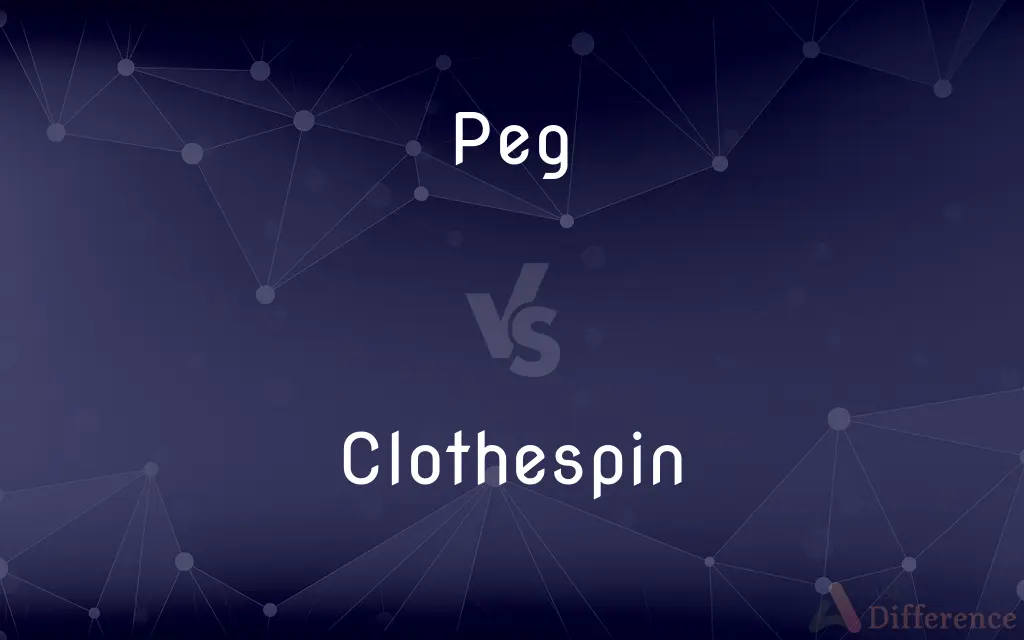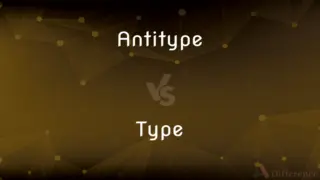Peg vs. Clothespin — What's the Difference?
By Fiza Rafique & Urooj Arif — Updated on April 2, 2024
Pegs are simple fasteners, often wooden, while clothespins are specifically designed for securing clothes to a line.

Difference Between Peg and Clothespin
Table of Contents
ADVERTISEMENT
Key Differences
A peg is a general term that refers to a small cylindrical or tapered piece used to fasten or as a support, often made of wood or plastic. Pegs have various applications, from securing items in place to serving as placeholders in board games. Clothespins, on the other hand, are a specific type of peg designed for hanging laundry on a line to dry. Clothespins typically have a spring mechanism or a simple two-piece wooden design that allows them to clamp onto clothes and the line securely.
While pegs can be used in a broad range of contexts, clothespins are specialized for laundry and fabric-related uses. The design of a clothespin, whether it is the traditional wooden style or the more modern spring-loaded version, is tailored to grip fabric without causing damage. Pegs might be used for similar purposes but lack the specific design features that make clothespins effective for holding clothes in place against the wind.
The materials from which pegs and clothespins are made also differ based on their intended use. Pegs might be found in a variety of materials, including metal, wood, or plastic, depending on their application. Clothespins, though traditionally wooden, are now also commonly available in plastic and sometimes metal, materials chosen for their durability and resistance to weather conditions.
Culturally, pegs have a wider range of significance, appearing in traditional games, crafts, and as simple tools in various settings. Clothespins, while practical, have a more focused cultural representation, often associated with domestic chores and the bygone era of line-drying clothes outdoors. This specificity lends clothespins a nostalgic quality, especially in regions where electric dryers have largely replaced outdoor drying.
The evolution of pegs and clothespins reflects the adaptation of simple tools to meet specific human needs. While pegs remain a versatile fastening solution for multiple scenarios, clothespins have evolved to meet the specific need of hanging laundry efficiently. This specialization illustrates the human tendency to innovate on basic designs to improve functionality for particular tasks.
ADVERTISEMENT
Comparison Chart
Design
Simple, cylindrical or tapered shape
Designed with a spring mechanism or as a two-piece clamp
Use
General fastening or support
Specifically for hanging laundry
Material
Wood, plastic, metal
Traditionally wood, now also plastic and metal
Cultural Significance
Broad, used in games, crafts
Associated with domestic chores, nostalgia for line-drying
Specialization
Versatile, used in various contexts
Highly specialized for securing clothes to lines
Compare with Definitions
Peg
A piece used in board games as a placeholder.
We moved the pegs around the board to track our progress.
Clothespin
A device designed to hold clothes securely without damage.
The clothespin held the delicate fabric gently but firmly.
Peg
A short cylindrical piece used to fasten or as support.
She used a wooden peg to secure the tent.
Clothespin
A clamp for hanging laundry on a line.
She clipped the shirt to the line with a clothespin.
Peg
A tool for securing items in place.
The carpenter hammered pegs into the wood to join the pieces.
Clothespin
Associated with domestic tasks.
Using clothespins, she remembered her grandmother's stories of past chores.
Peg
A basic utility object found in various settings.
She used a peg to mark her place in the garden.
Clothespin
A wooden or plastic clip with a spring mechanism.
The spring-loaded clothespin made it easy to hang heavy towels.
Peg
A simple fastener made of wood or plastic.
He used a peg to hang his hat on the wall.
Clothespin
Traditionally used for line-drying clothes.
Clothespins scattered the yard on laundry day.
Peg
A small cylindrical or tapered pin, as of wood, used to fasten things or plug a hole.
Clothespin
A clothespin (US English), or clothes peg (UK English) is a fastener used to hang up clothes for drying, usually on a clothes line. Clothespins often come in many different designs.
Peg
A similar pin forming a projection that may be used as a support or boundary marker.
Clothespin
A clip of wood or plastic for fastening clothes to a clothesline.
Peg
(Music) One of the pins of a stringed instrument that are turned to tighten or slacken the strings so as to regulate their pitch.
Clothespin
A clip or fastener used to secure garments to a clothesline while drying, and sometimes for other applications requiring holding or pinching.
Peg
A degree or notch, as in estimation
Our opinion of him went up a few pegs after he did the dishes.
Clothespin
(transitive) To affix with a clothespin.
Peg
Chiefly British A drink of liquor.
Clothespin
A forked piece of wood or plastic, or a small device with a spring clamp, used for fastening clothes on a line.
Peg
(Baseball) A low and fast throw made to put a base runner out.
Clothespin
Wood or plastic fastener; for holding clothes on a clothesline
Peg
(Informal) A leg, especially a wooden one.
Peg
To fasten or plug with a peg or pegs.
Peg
To designate or mark by means of a peg or pegs.
Peg
To fix (a price) at a certain level or within a certain range.
Peg
(Informal) To classify; categorize
I pegged her as an opportunist. Why do you have me pegged as the rowdy one?.
Peg
To hit, especially with a thrown object or fired projectile
She pegged him on the head with a snowball.
Peg
To throw or fire (an object or projectile)
“How did you learn to peg a ball as straight as this?” (Zane Grey).
Peg
To work steadily; persist
Pegged away until our luck turned.
Peg
Wide at the top and narrowing toward the bottom
Peg jeans.
A peg skirt.
Peg
A cylindrical wooden or metal object used to fasten or as a bearing between objects.
Peg
A protrusion used to hang things on.
Hang your coat on the peg and come in.
Peg
(figurative) A support; a reason; a pretext.
A peg to hang a claim upon
Peg
(cribbage) A peg moved on a crib board to keep score.
Peg
(finance) A fixed exchange rate, where a currency's value is matched to the value of another currency or measure such as gold.
Peg
(UK) A small quantity of a strong alcoholic beverage.
Peg
A place formally allotted for fishing
Peg
A leg or foot.
Peg
One of the pins of a musical instrument, on which the strings are strained.
Peg
A step; a degree.
Peg
Ellipsis of clothes peg
Peg
(journalism) A topic of interest, such as an ongoing event or an anniversary, around which various features can be developed.
Peg
A stump.
Peg
(slang) The penetration of one's (male) partner in the anus using a dildo.
Get your strap-on out and give me a nice peg!
Peg
A serving of brandy and soda.
Peg
(India) A serving of any hard spirit, particularly whisky.
Peg
A shilling.
Peg
(transitive) To fasten using a peg.
Let's peg the rug to the floor.
Peg
(transitive) To affix or pin.
I found a tack and pegged your picture to the bulletin board.
She lunged forward and pegged him to the wall.
Peg
(transitive) To fix a value or price.
China's currency is no longer pegged to the American dollar.
Peg
(transitive) To narrow the cuff openings of a pair of pants so that the legs take on a peg shape.
Peg
To throw.
Peg
To indicate or ascribe an attribute to. (Assumed to originate from the use of pegs or pins as markers on a bulletin board or a list.)
He's been pegged as a suspect.
I pegged his weight at 165.
Peg
(cribbage) To move one's pegs to indicate points scored; to score with a peg.
She pegged twelve points.
Peg
To reach or exceed the maximum value on (a scale or gauge).
We pegged the speedometer across the flats.
Peg
(intransitive) To keep working hard at something; to peg away.
Peg
To drink alcohol frequently, especially brandy and soda; to tipple.
Peg
A small, pointed piece of wood, used in fastening boards together, in attaching the soles of boots or shoes, etc.; as, a shoe peg.
Peg
A wooden pin, or nail, on which to hang things, as coats, etc. Hence, colloquially and figuratively: A support; a reason; a pretext; as, a peg to hang a claim upon.
Peg
One of the pins of a musical instrument, on which the strings are strained.
Peg
One of the pins used for marking points on a cribbage board.
Peg
A step; a degree; esp. in the slang phrase "To take one down a peg."
To screw papal authority to the highest peg.
And took your grandees down a peg.
Peg
A drink of spirits, usually whisky or brandy diluted with soda water.
This over, the club will be visited for a "peg," Anglice drink.
Peg
A hard throw, especially one made to put out a baserunner; as, the peg to the plate went wild.
Peg
To put pegs into; to fasten the parts of with pegs; as, to peg shoes; to confine with pegs; to restrict or limit closely.
I will rend an oakAnd peg thee in his knotty entrails.
Peg
To score with a peg, as points in the game; as, she pegged twelwe points.
Peg
To identify; to recognize; as, she pegged him as a good carpenter; he was pegged as a blowhard as soon as he started speaking; he was pegged as a exceptional player even in high school.
Peg
To throw (a ball); as, he pegged the runner out at second.
Peg
To work diligently, as one who pegs shoes; - usually with on, at, or away; as, to peg away at a task.
Peg
A wooden pin pushed or driven into a surface
Peg
Small markers inserted into a surface to mark scores or define locations etc.
Peg
Informal terms of the leg;
Fever left him weak on his sticks
Peg
A prosthesis that replaces a missing leg
Peg
Regulator that can be turned to regulate the pitch of the strings of a stringed instrument
Peg
A holder attached to the gunwale of a boat that holds the oar in place and acts as a fulcrum for rowing
Peg
Succeed in obtaining a position;
He nailed down a spot at Harvard
Peg
Pierce with a wooden pin or knock or thrust a wooden pin into into
Peg
Fasten or secure with a wooden pin;
Peg a tent
Peg
Stabilize (the price of a commodity or an exchange rate) by legislation or market operations;
The weak currency was pegged to the US Dollar
Common Curiosities
Do people still use clothespins?
Yes, clothespins are still used, especially by those who prefer line-drying clothes for environmental reasons or to preserve fabric integrity.
What materials are clothespins made from?
Clothespins are made from wood, plastic, and sometimes metal, chosen for durability and weather resistance.
What is the primary use of a peg?
A peg is used for fastening or as a support in a wide range of applications, from securing items to serving as placeholders in games.
How have clothespins evolved over time?
Clothespins have evolved from simple wooden designs to include spring-loaded mechanisms, reflecting improvements in functionality and ease of use.
How does a clothespin work?
A clothespin works by clamping onto clothes and a line, using either a spring mechanism or a simple two-piece design to secure laundry without damage.
Can clothespins be used for other purposes besides hanging laundry?
Yes, clothespins can be used creatively for crafts, organizing, and decorative purposes beyond laundry.
Are pegs considered tools?
Yes, pegs are considered simple tools used for securing or supporting various items in multiple contexts.
Can pegs be used for hanging clothes?
While pegs can technically be used to hang clothes, clothespins are specifically designed for this purpose and are more effective.
What is the cultural significance of clothespins?
Clothespins are often associated with domestic chores and nostalgia for the tradition of line-drying clothes outdoors.
What is the difference between a wooden and a plastic clothespin?
The main difference lies in the material's durability and resistance to weather, with plastic often being more durable and less prone to weather damage than wood.
Share Your Discovery

Previous Comparison
Antitype vs. Type
Next Comparison
Punishment vs. CurseAuthor Spotlight
Written by
Fiza RafiqueFiza Rafique is a skilled content writer at AskDifference.com, where she meticulously refines and enhances written pieces. Drawing from her vast editorial expertise, Fiza ensures clarity, accuracy, and precision in every article. Passionate about language, she continually seeks to elevate the quality of content for readers worldwide.
Co-written by
Urooj ArifUrooj is a skilled content writer at Ask Difference, known for her exceptional ability to simplify complex topics into engaging and informative content. With a passion for research and a flair for clear, concise writing, she consistently delivers articles that resonate with our diverse audience.













































